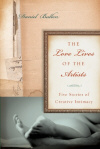The Love Lives of the Artists
Daniel Bullen delivers an intimate account of five artist-couples whose relationships stepped outside of the status quo of the times in which they lived. He admits that his interest in the subject is personal. In writing this book he was “looking for the language to reconcile marriage and desire.” Any long-lasting intimate relationship of significance is bound to be a tricky endeavor—prone to be often full of mishaps, some a matter of chance, others deliberately pursued. Bullen’s book is more concerned with the latter; the individuals in these relationships each pursue multiple lovers, leading to hopelessly complicated love lives.
Daniel Bullen delivers an intimate account of five artist-couples whose relationships stepped outside of the status quo of the times in which they lived. He admits that his interest in the subject is personal. In writing this book he was “looking for the language to reconcile marriage and desire.” Any long-lasting intimate relationship of significance is bound to be a tricky endeavor—prone to be often full of mishaps, some a matter of chance, others deliberately pursued. Bullen’s book is more concerned with the latter; the individuals in these relationships each pursue multiple lovers, leading to hopelessly complicated love lives.
The pairings he explores range from artists of the literary, both philosophical and poetic, to those in the visual arts, and are in the following order: Lou Andreas-Salomé and Rainer Maria Rilke, Alfred Stieglitz and Georgia O’Keeffe, Jean-Paul Sartre and Simone de Beauvoir, Diego Rivera and Frida Kahlo, and Henry Miller and Anaïs Nin. Bullen’s inquiry covers a broad swath of all available materials on his subjects and is therefore a fitting place to begin for readers with little prior knowledge of these artists. If you happen to enjoy, say, Kahlo’s paintings or admire Steiglitz’s work with artists in his galleries and Camera Work, and are curious to learn about their personal lives, this is a handily informative book. On the other hand, if you know nothing at all about any of these artists but are interested in love relationships between artists in general, this book is likewise informative and worth your while.
Bullen’s focus is on relationships that are both artist-to-artist in nature and not the least bit monogamous. He points out: “They were not, after all, Rodins, Gertrude Steins, or Willa Cathers, with longtime nonartist companions—they weren’t Faulkners, with nonartist wives and lovers, they weren’t Hemingways or Picassos, with serial marriages, to beautiful women who were not also artists.” His interest centers upon relationships that might, even if problematically, be seen as being between equals. In most cases, if one partner in one of these couples caused the other to suffer, it was undoubtedly returned in kind by the other at some point. To be sure, these are relationships which were suffered through, but suffered through for the benefit of Art. These couples remain heroic champions for Bullen, carving out unknown territory between lovers as individuals against society’s norms, all for Art’s sake:
The artists’ relationships were not only open to lovers: they were also open to the sex urge and jealousy, and all the chaotic emotions their parents had hoped they would free themselves from by making recognizable marriages. But with the power to make decisions about what to claim as their own, and what to renounce as merely the world’s, or history’s, or nature’s, the artists’ individualities themselves seemed to obligate them to make decisions, and create things, that would reveal their personalities. In their relationships with each other—the equals who shared their visions—they really entered into the most intimate relationships with themselves. In their relationships, they encouraged each other to become their own ideas of themselves; to relinquish or transform what was not theirs, and to invent forms that would give them expression; to say the things, and be the selves no one had let them be anywhere else. Now their flaws and frustrations and lusts and rebellions and failures were just understandable, even forgivable human reactions, and all of it was just raw material for art: together they could forgive each other their human lives and failings—so long as they continued to create.
These are not always endearing stories—surprised!? Turns out personal lives of artists, like everybody else, are often quite messy. The lesson to be found here, even if it arrives with some slight distaste and mild shock, is that everyone must ultimately discover their own ways to love and that “true love” is actualized in many different ways, thankfully as individual as Art itself is.
Bullen should be commended for leaving all the rough edges exposed. Nin, it appears, did in fact successfully pursue a sexual relationship with her father later in her adult life. Such facts are not for the squeamishly staid. However, nothing here is likely to shock today’s readers who are immersed in the televised “reality” of both stars and non-stars of the entertainment world. For readers living honest, open romantic lives with several lovers, these stories will strengthen pre-existing bonds, further reaffirming the fact that there is no so-called correct course for romance to take. In the end, Bullen’s book affirms that what’s important in Art, or much of anything else in life, is staying committed to doing whatever’s needed to accomplish the vision given you. Nothing else matters.





